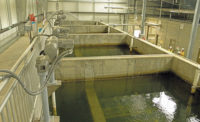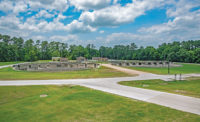Construction of an 8-mgd Water Treatment Plant
Falmouth, Mass.
Best Project
Owner: Town of Falmouth, Mass.
Lead Designer: Tata & Howard Inc.
General Contractor: Methuen Construction Co.
MEP Engineer: CH2M Hill Inc. (CH2M)
Concrete Contractor: VR Concrete Inc.
Electrical Contractor: Wayne J. Griffin Electric Inc.
Despite the pressures associated with an accelerated schedule and unanticipated subsurface conditions that prompted a “workaround,” the team for the water treatment plant safely built an 8.4-million-gallon-per-day facility.
Built in 24 months, the plant reduces disinfection byproducts, removes pathogens, improves taste, reduces odor, removes algae toxins and reduces organics.
Unlike its predecessor, the plant meets current federal and state regulations. The elder Long Pond Pump Station, built in the 1890s, had operated under a Massachusetts Dept. of Environmental Protection filtration waiver and did not meet current requirements of the U.S. EPA’s Long Term 2 Enhanced Surface Water Treatment Rule. The old water treatment facility decommissioning began Nov. 13.
Designer Tata & Howard evaluated 22 treatment processes and pilot-tested eight treatment alternatives.
The completed plant uses coagulation, mixing, flocculation, dissolved air flotation, dual media filtration—including granular activated carbon above sand and chemical feed systems—and an intermediate ozone feed to provide stable water quality and the flexibility to meet uncertain future regulatory and water-quality challenges.
To help accelerate the project, the team used horizontal directional drilling instead of open cut excavation for the intakes for untreated pond water pumped to the head of the plant to start the treatment process.
The team estimates that open cut excavation could have taken more than a month to complete whereas directional drilling took only one week.
The directional drilling method floated 200 ft of 24-in.-dia intakes into the pond, avoiding any excavations in the pond itself. The method also was less disruptive to aquatic life and reduced the risk of violating state, local and federal environmental regulations.
During construction of the raw water intake and pump station, crews encountered unexpected subsurface conditions such as small boulders, known as cobbles, that affected the directional drilling and forced a modification of the layout for each intake pipeline.
That in turn prevented the fastening of each 3-in. air burst line to the associated intake pipeline, so crews had to use directional drilling for each of the two air burst lines separate from each of the two intake pipelines.
The unanticipated subsurface conditions also affected the schedule for installation of a temporary dewatering system for the raw water pump-station wet-well construction.
There were no lost-time accidents during 125,305 worker-hours. The project had a perfect OSHA recordable incident rate.
Two certified safety professionals were assigned to the project. In addition to regular site safety inspections and evaluations, they provided weekly safety training on pertinent safety issues, such as fall protection, scaffold safety, handling of silica dust, hearing safety, dealing with concrete chemical burns, and rebar and formwork installation.
Before work began each morning, the site supervisor discussed activity plans with team leaders, including subcontractors. The goal was to prepare for the day’s work and all safety-related issues.
Related Article: Innovation Permeates Region's Top Work





